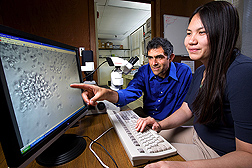| Read the magazine story to find out more |
|
|
|
|
A Faster, Less Costly Test Detects Foodborne Toxin
May 10, 2017
Good news on the food-safety front: Agricultural Research Service (ARS) scientists have developed a new test that's faster, more sensitive and less expensive than current tests in detecting a major foodborne toxin.
The bacterium Staphylococcus aureus, which makes a variety of toxins, is one of the most common causes of food poisoning. One such toxin, staphylococcal enterotoxin type E (SEE), has been associated with outbreaks in the United States and other countries.
In the United States, more than 48 million people get sick, 128,000 are hospitalized, and 3,000 die of foodborne diseases each year, according to the Centers for Disease Control and Prevention. Of that group, staphylococcal food poisoning causes an estimated 240,000 illnesses, 1,000 hospitalizations and six deaths annually.
Chemist Reuven Rasooly and his colleagues at the ARS Western Regional Research Center, in Albany, California, developed a T-cell test that specifically detects SEE in foods. T-cells are a type of white blood cell that helps with the body's immune system responses. The current method for detecting these toxins is an animal model, which is expensive, has low sensitivity and is difficult to reproduce. Other tests used to detect toxins cannot distinguish between active toxin, which does pose a threat to public health, and inactive toxin, which does not.
The animal-model test detects active toxin only 50 percent of the time compared to the new T-cell test, which detects it 100 percent of the time. The T-cell test also detects toxin within five hours compared to 48 to 72 hours for other tests.
The T-cell test can be used by food makers to help keep products safer before they're sold and by public health officials to trace the source of foodborne outbreaks.
A patent application for the new T-cell test has been filed by ARS.
Read more about this research in the May issue of AgResearch.
For more information contact Sandra Avant, ARS Office of Communications.
The Agricultural Research Service is the U.S. Department of Agriculture's chief scientific in-house research agency. Daily, ARS focuses on solutions to agricultural problems affecting America. Each dollar invested in agricultural research results in $17 of economic impact.

